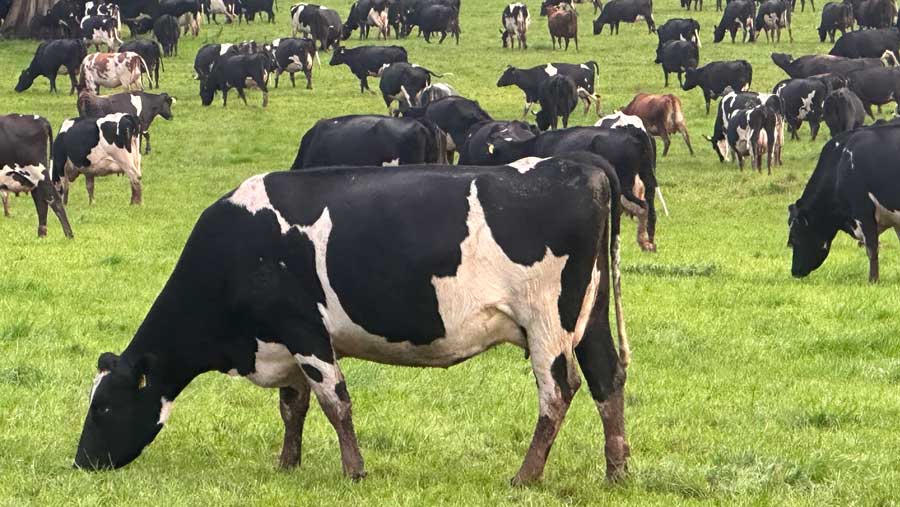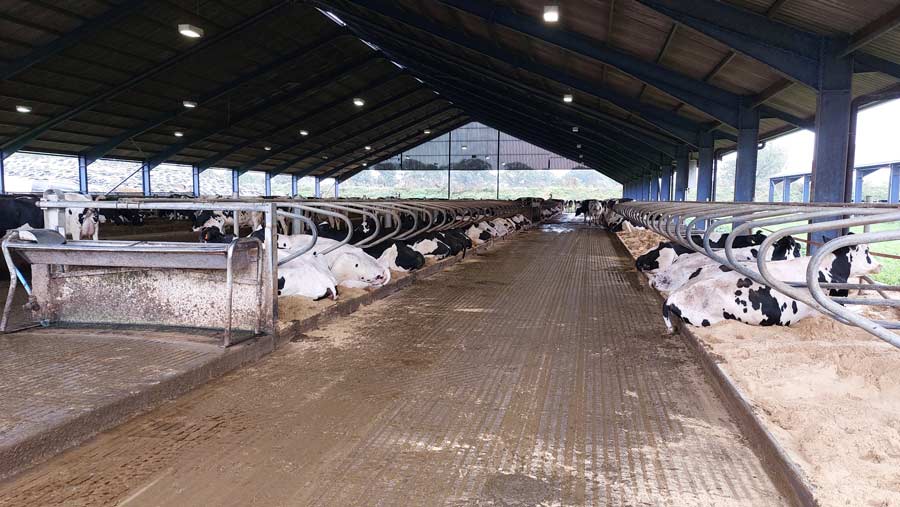Why two systems are running separate heifer milking groups
 Sansaw heifers © Sansaw Estate
Sansaw heifers © Sansaw Estate Milking heifers separately from cows has improved social cohesion and reduced bullying for a block-calving herd and an all-year-round setup at Sansaw Estate in Shropshire.
This spring block-calving herd has run a heifer group since 2016, and farm manager Breiffni Daly is confident they benefit.
See also: 12 tips on rearing heifers to last longer
“The heifers have known each other their whole life, so there is no bullying in the group, and they can walk to and from the parlour in their own time,” he says, adding that previously, there was competition for grass and bullying from older cows.
“The only disadvantage is that, after milking, although they know how to walk out to the paddocks, not all of them go to graze.
“Some stand on the tracks or in the yard, so it’s handy now having second-lactation animals in the group this year to help lead them.”
How it works
The farm’s layout required two mobs of cows to make efficient use of the grazing platform, so the team decided to run first calvers in one group, with mature cows in another.
There are now 480 first calvers, plus 200 of the lightest second calvers, together.
Heifers calve in the first six weeks of the block, starting two weeks ahead of the main herd.
They are trained to the rotary parlour beforehand, using it six times prior to being milked.
They have also been rotational grazing and are used to an electric fence since weaning.
Farm facts: Sansaw Estate
- 1,500 cows
- 900 youngstock on average
- 540ha milking platform accessed via six underpasses
- New Zealand genetics
- 5,285 litres a cow
- 452kg milk solids a cow
- 750kg concentrates/year
- Calving from 1 February for 10 weeks
Concentrates are fed at 4kg/day during calving, dropping to 2kg for breeding, depending on grazing.
“Heifers don’t eat as much grass as the mature group, even though they are still growing. We allocate 14kg dry matter (DM)/day and they need 15-16kg.
“Mature cows eat 17-18kg DM/day. We have to watch residuals, as heifers can be more selective, which is a challenge in April because grass can easily get ahead of them,” says Breiffni.
At the end of their first lactation, heifers are given a 12-week dry period and outwintered on fodder beet.
They come indoors two weeks pre-calving and are trained to cubicles bedded with straw.
The rest of the herd is housed in cubicles, on a self-feed silage system.
This year, to help with mastitis control, the heifer mob was milked first. “We now have a heifer herd cell count of 140,000 cells/ml – with cows at 293,000 cells/ml.
“It also means we can bring in extra people at the start of milking to help with heifers as it takes them two to three months to settle.”
Body condition
Breiffni sees a huge difference in body condition in the heifer mob and says they do not lose weight after calving as cows do.
He reports that 78% of last year’s first-lactation heifers calved down again in 2023, but he would like to get this figure closer to 90%.
Despite last year’s drought, production averaged 3,893 litres and 325kg milk solids a heifer, which is in the typical range of 3,600-4,200 litres.
They had a mastitis rate of 14%, compared with 36% for the cow group, and 18% lameness, compared with 30% for cows.
It is easier to make a heifer group when you have scale, admits Breiffni.
But he thinks any herd of 300 cows or more can manage it with the right infrastructure, logistics and grazing.
Sansaw Estate results 2022 |
|||||||
|
|
Number in group |
Days in milk |
Average bodyweight (kg) |
Milk solids as % of bodyweight |
Calved six weeks 2023 (%) |
Six-week in-calf rate 2023 (%) |
Three-week submission rate 2023 (%) |
|
First lactation |
374 |
277 |
410 |
80 |
88.7 |
76.1 |
92.6 |
|
Mature cows |
754 |
273 |
493 |
93 |
81.9 |
76.6 |
90.8 |
Further investment planned for all-year-round herd

© MAG/Shirley Macmillan
A positive experience running a separate heifer milking group on another farm convinced Norfolk milk producer Alex Dann, of Pound Farm, North Tuddenham to include space for such a group in his new unit, built seven years ago.
Today, 115 regular-sized cow cubicles are occupied by 100 first-lactation heifers.
Cohorts of 10 heifers, reared and calved together, join this group each month, staying until they are dried off.
They then move to the purpose-built transition yard, with space for 60 dry cows on one dietary cation-anion balance (DCAB) diet for 60 days.
The farm also runs a high-yielding group and a late-lactation one.
Farm facts: Pound Farm, North Tuddenham, Norfolk
- 243ha owned; 61ha rented
- 410 Holsteins
- 12,000 litres at 4.1% fat and 3.3% protein
- Three-times-a-day milking
- 30 cows calving a month
- 10 heifers calving a month
- Replacement rate 25%
Alex believes that milking heifers in a separate group is ideal: “Socially, I think it is the right thing to do, and they look fine at the end of their first lactation – they grow a lot,” he says.
However, a lack of suitable housing, combined with herd expansion, has meant that heifers were contract-reared off farm, between weaning and calving, until this winter.
And he is disappointed with this year’s milking heifers, saying they are the “worst-performing group” he has had.
“They picked up diseases elsewhere. Once we put them in with the transition cows, a week before calving, they were stressed.
“They hadn’t even seen a cubicle. We want to invest this year in new calf and heifer facilities to grow them well.”
Calf management
Alex has now brought all heifer rearing home, overseen by a new youngstock manager.
Calves are reared in single pens for the first 10 days until drinking well, then grouped. By six weeks, they are in pens of 10, with weaning based on weight.
He has also just bought some second-hand cubicles for pregnant heifers to train them and put them on a straw-based total mixed ration (TMR) to maintain diet consistency as they grow up.
The herd is on a full TMR with no additional concentrates. Heifers are fed the same ration with 3.5 tonnes of concentrates. The mature lactation group is fed 3.95 tonnes of concentrates.
The diet comprises four home-grown forages: lucerne, grass, wholecrop barley and maize, plus straight rapemeal, bypass urea, urea-treated barley and caustic wheat.
Dry matter intakes for heifers average 26-27kg/day, with fresh cows on 31kg.
The first-lactation group is currently yielding 27 litres/day, compared with 35 litres/day for cows, amounting to 8,500 litres over the whole lactation.
“The herd averages 11-12 cases of mastitis for every 100 cows and we get very few in the heifer group, usually a summer mastitis.
Fertility in heifers is 36% conception rate, with maiden heifers at 55% and second-lactation cows at 41%,” says Alex.
Further improvements
He acknowledges transition for heifers could be improved and plans to expand the yard of 60 cubicles by adding a separate row of 30, plus calving pens, just for in-calf heifers.
With the benefit of his experience, he would install smaller cubicles for a heifer group, as some of them tend to muck the sand beds.
“We have a small straw yard and I’d like to keep them in it for 24 hours after calving. Heifers are definitely calmer at calving these days.”